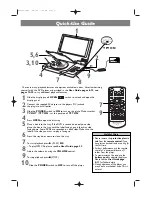
ES Series Models II/III Portable Radio Operating Manual
7-13
Multi-Net Features
appears. Drive closer to the radio system or away from shielding structures and try
again. Normally, the radio automatically changes sites if an out-of-range condition
occurs (see Section 7.13.1).
- When responding, busy or out-of-range conditions may also occur as when placing a
call because the system is re-accessed for each transmission.
3
When the call is finished, no special termination procedure is required.
7.9.2
Receiving a Group Call
• To receive a group call, the channel programmed for the group must be selected or
scanned, or it must be on a priority or a block group of the selected system.
• When group call is received, the alias of the group on which it is received is normally
displayed. An exception is when a call on a block ID is received. “BLOCK RCVD” is
then displayed for the duration of the call.
• The radio can be programmed so that along with the group alias, the Unit ID and
talkgroup ID of the calling radio are displayed, either once or alternated at
programmable intervals for the duration of the call.
• If scanning or the call is received on a priority ID, a response may not occur on the
group of the call, depending on the programmed talk back mode (see Sections 7.8.4 and
7.2.2).
7.10 Multi-Net Special Calls
Multi-Net special calls use the special call ID codes from 226-254. The special calls
typically originated by a subscriber unit are Telephone (Interconnect) which use ID 237
and Unit (Unique ID) which uses ID 236 (see following information). When a telephone
call is selected,
is displayed. Likewise, when an Unit call is selected,
is
displayed. A radio with a DTMF keypad and/or pre programmed system lists are required
to place special calls.
Note
Interconnect and Unique ID calls are not channel selectable and may be disabled by
programming.
Most other special calls such as Interrogate, Mobile Disable, and Reassignment are
originated by the system operator or a dispatcher.
The Multi-Net special calls are as follows.
Telephone Call
- This is a call using the PSTN (Public Switched Telephone Network).
Since the radio operates half duplex, the PTT switch must be pressed to talk and
Summary of Contents for 5100 ES
Page 2: ......
Page 4: ......
Page 14: ...viii ES Series Models II III Portable Radio Operating Manual List of Figures ...
Page 16: ...viii ES Series Models II III Portable Radio Operating Manual List of Tables ...
Page 26: ...1 6 ES Series Models II III Portable Radio Operating Manual Features ...
Page 74: ...4 18 ES Series Models II III Portable Radio Operating Manual Radio wide Features ...
Page 162: ...7 26 ES Series Models II III Portable Radio Operating Manual Multi Net Features ...
Page 168: ...8 6 ES Series Models II III Portable Radio Operating Manual Miscellaneous ...
Page 174: ...10 4 ES Series Models II III Portable Radio Operating Manual Passwords ...
Page 184: ...11 10 ES Series Models II III Portable Radio Operating Manual Secure Communication Encryption ...
















































